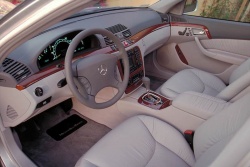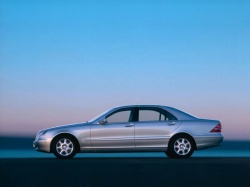Another suspension-related system to be aware of is called Active Body Control (ABC), a mess of hydraulics designed to eliminate much of the car’s body movements in cornerning, braking and acceleration. This thread, pulled from the W220 Encyclopedia linked to above, details ABC, its operation and potential problems.
The electronics – power equipment and audio systems being the worst offenders, with climate control figuring in as well – in early versions of this S-Class were troublesome, but word among those who know these cars is that many of these issues were worked out in later model years.
 2004 Mercedes-Benz S430. Click image to enlarge |
Instrument clusters are a common failure point. The reason is for one of three different faults that affect cars built at different times during the model’s production. Mercedes-Benz Canada will consider replacing faulty instrument clusters in Canadian W220s on a case-by-case basis, an offer that is transferable to subsequent owners.
Consumer Reports’ information suggests that the folks in the forums have a good idea of what they’re talking about. CR gives the W220 S-Class an average or slightly below average used vehicle rating for all model years between 2000 and 2006.
Consumer Reports’ information suggests that the folks in the forums have a good idea of what they’re talking about. CR gives the W220 S-Class an average or slightly below average used vehicle rating for all model years between 2000 and 2006.
Click here and here for a couple of very good “What to look out for in a used S-Class” type threads at BenzWorld.org.
In 2000, Natural Resources Canada’s fuel consumption ratings for the S-Class were 13.7/8.9 L/100 km (all figures city/highway) in the S430 and 14.4/9.6 in the S500. The 2001 S600 was rated 15.2/9.3.
Ratings for the S55 AMG will be something like 16.6/10.3 (these numbers being for a 2004 model), while the 2004 S600 was rated at 18.9/11.6. Ratings for the 2006 S600 and S65 models were in the same ballpark. Note that all-wheel drive versions will use as much as ten per cent more fuel in the city, while the penalty on highway driving is less severe.
Neither the Insurance Institute for Highway Safety (IIHS) nor the National Highway Traffic Safety Administration (NHTSA) crash tested the W220; not even EuroNCAP has crash safety data on the car.
 2004 Mercedes-Benz S500. Click image to enlarge |
According to Canadian Black Book (CBB), used S-Class pricing ranges from $10,825 for a 2000 S 430 short-wheelbase model to a high of $62,125 for a 2006 S600; CBB doesn’t list a value for the S65. The 2006 S600’s value of $62,125 is a good indicator of how quickly cars in this price range depreciate: its MSRP when new was $190,500. A 2004 S500 is worth about $18,750 and a 2006 S500 carries a value of $22,575, both of which are far cries from the cars’ $120,000-plus MSRPs.
Paying less than $25,000 for a car packed with this much luxury and prestige sounds like a bargain, and for the driving experience alone, it is. What aspiring car shoppers need to remember, though, is that the cost of maintaining a car like this can take all the enjoyment out of the ownership experience if you’re not prepared for the expense.
If you want prestige and reliability, avoid the German uber-sedans and choose a Lexus LS 430. A 2006 model is worth $28,425, according to CBB, and Consumer Reports gives it the publication’s “good bet” used vehicle recommendation.
There’s something to be said for the S-Class’ heritage, though, so if that’s a must-have for you, then the only advice I have is to know what you’re getting into before you buy. Doing so won’t ensure you get a flawlessly reliable car, but it will prepare you for the high cost of keeping the car on the road.
|
Pricing
Black Book Pricing (avg. retail) June 2009:
Online resources
Recalls
2001: Certain vehicles are equipped with a heated windshield washer bottle which may be defective. The sheathing material on the electrical connection of the hose may overheat and cause surrounding plastic and insulation to melt. This could eventually result in a an engine compartment fire. Correction: Heated windshield washer bottle hose will be replaced. Transport Canada Recall Number: 2003029; Units affected: 2,884 Transport Canada Recall Number: 2004153; Units affected: 277 (includes affected CL-Class models) Transport Canada Recall Number: 2004154; Units affected: 2,246 (includes affected CL-Class models) Transport Canada Recall Number: 2004184; Units affected: 859 (includes affected CL-Class models) Transport Canada Recall Number: 2006031; Units affected: 1,313 (includes affected CL-Class models) Transport Canada Recall Number: 2007195; Units affected: 884 (includes affected CL-Class models) Transport Canada Recall Number: 2008290; Units affected: 279 (includes affected CL- and SL-Class models)
Crash test results
Used vehicle prices vary depending on factors such as general condition, odometer reading, usage history and options fitted. Always have a used vehicle checked by an experienced auto technician before you buy. For information on recalls, see Transport Canada’s web-site, www.tc.gc.ca, or the U.S. National Highway Transportation Administration (NHTSA)web-site, www.nhtsa.dot.gov. For information on vehicle service bulletins issued by the manufacturer, visit www.nhtsa.dot.gov. For information on consumer complaints about specific models, see www.lemonaidcars.com. |











